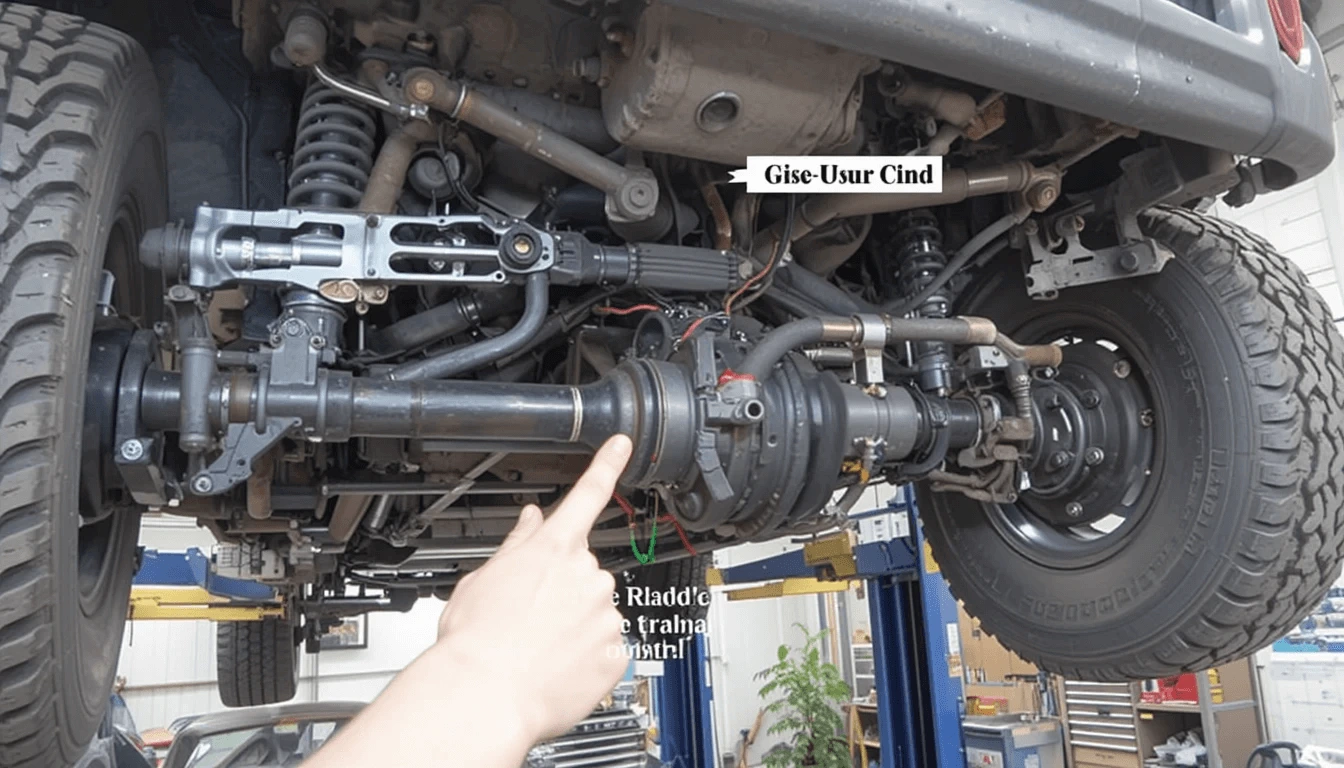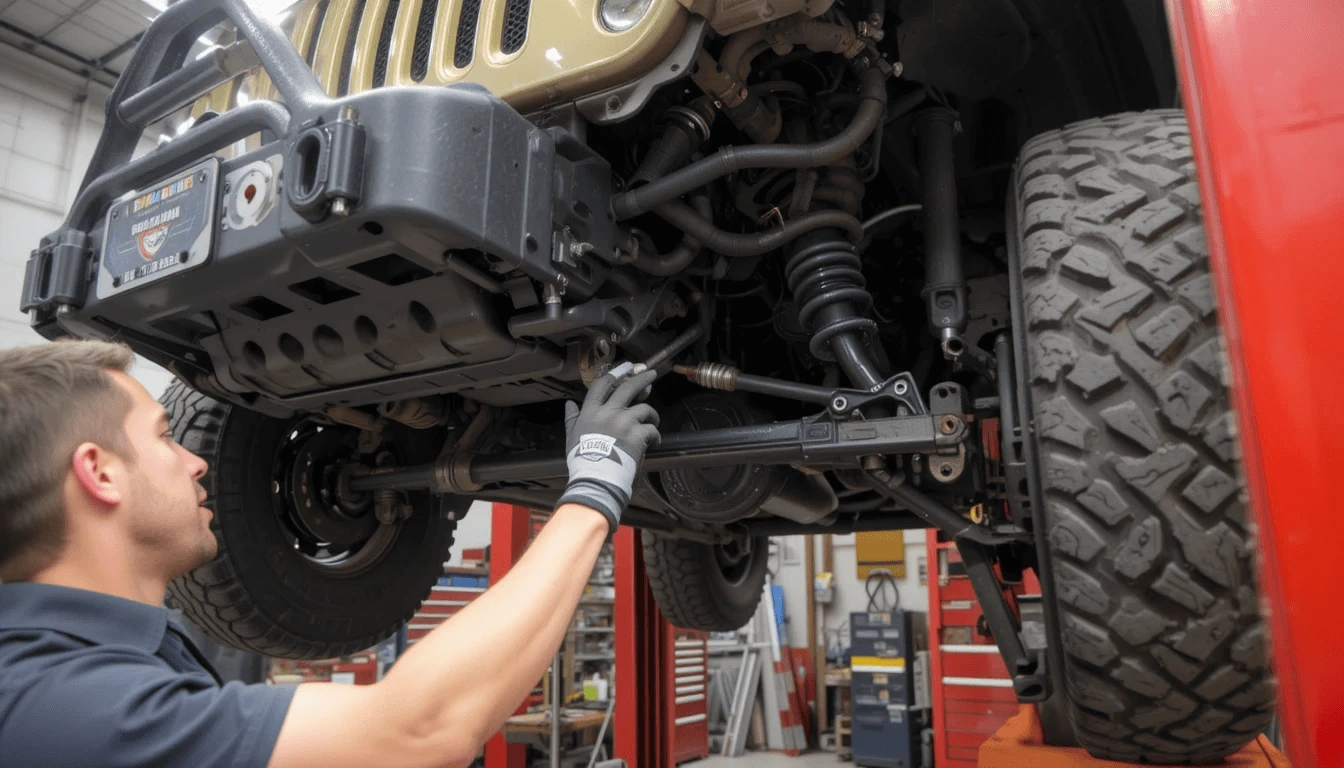“This image is AI-generated for illustrative purposes only and does not depict any specific vehicle brand or model.”
You’re cruising down the highway in your Jeep, enjoying the drive, when suddenly the steering wheel starts shaking violently. Your heart races as you grip the wheel tighter, hoping it stops. Sound familiar? You might’ve just experienced what many refer to as the Death Wobble Jeep issue—a sudden, intense vibration that can catch you off guard and make steering feel unsafe.
But don’t worry; Here’s how you can understand the problem and take the right steps to fix and prevent it.
Related Reads:
- Ford Recalls 2024 Ranger Pickups Over Window Pinching Issue—How to Fix It
- Ford Maverick Recall: How to Check If Your Truck Needs Repairs
- Check Engine Light Flashing? Reasons & How to Fix It
- GMC & Chevrolet Trucks Tailgate Recall: What to Know
- 2024 GMC Yukon Updates: What’s New & Why It Matters
What Is the Jeep Death Wobble?

Definition and Explanation
The “death wobble” refers to a sudden and violent shaking of the front wheels, usually occurring after hitting a bump at speeds above 45 mph. It primarily affects vehicles with solid front axles, like the Jeep Wrangler and certain Jeep Cherokee models. Unlike minor vibrations, the death wobble can make steering control difficult and dangerous.
Curious about something similar? Take a look at the 2025 GMC Hummer EV SUV Review: Ultimate Off-Road Power.
Why Is It Called the “Death Wobble”?
Despite the ominous name, it rarely leads to accidents if you respond correctly. However, the term “death wobble” sticks because the shaking feels severe and alarming.
How It Affects Jeep Owners
Many Jeep owners have reported this experience over the years, especially in models with solid front axles. According to a 2019 FCA (Fiat Chrysler Automobiles) report, complaints about the death wobble peaked after the release of the Jeep Wrangler JL model in 2018. While the issue has been around for a while, owner awareness and discussions have increased thanks to online communities.
What Causes the Death Wobble in Jeeps?
Common Mechanical Causes
While the death wobble often stems from a combination of factors, the most common culprits include:
- Loose or Worn Track Bar: The track bar keeps your axle centered. If its bushings or bolts are worn, even a slight bump can trigger the wobble.
- Damaged Tie Rod Ends and Ball Joints: These components play crucial roles in steering. Worn parts create slack that leads to instability.
- Faulty Control Arms: Loose control arms allow unwanted axle movement.
Suspension and Steering System Issues
Your Jeep’s suspension system endures a lot, especially if you go off-road. Components like the steering stabilizer can mitigate vibrations but won’t solve underlying issues.
Impact of Lift Kits and Modifications
Many Jeep owners love adding lift kits for better off-road clearance. However, improper installation or failure to realign the suspension can cause the death wobble. Always get a professional alignment after modifications.
Alignment and Tire Issues
Even something as simple as unbalanced tires or misaligned wheels can trigger a wobble. Regular tire maintenance is crucial.
Signs and Symptoms of a Jeep Death Wobble
How to Identify the Death Wobble Early
Pay attention to these early warning signs:
- Steering feels loose or vague
- Unusual vibrations at certain speeds
- Clunking noises when driving over bumps
Warning Signs While Driving
The death wobble often strikes after hitting a pothole or speed bump. If your steering wheel begins to shake uncontrollably, reduce speed gradually and pull over safely.
Differences Between Regular Vibrations and Death Wobble
Unlike mild vibrations from tire imbalance, the death wobble is severe, making it feel like your Jeep is about to shake apart. Don’t ignore it—prolonged driving with a wobble can damage your vehicle further.
How to Fix the Jeep Death Wobble

Step-by-Step Diagnostic Process
- Inspect the Track Bar: check for loose bolts or worn bushings.
- Examine tie rods and ball joints: Look for excessive play or damage.
- Check Control Arms and Suspension Components: Tighten any loose bolts.
- Balance and Align Tires: Simple fixes like this often solve the issue.
DIY Fixes vs. Professional Repairs
Some Jeep owners can handle minor fixes themselves. However, for complex issues, especially involving suspension components, it’s safer to consult a mechanic.
Replacing Key Components
- Steering Stabilizer: A quick and affordable fix, but only a temporary solution.
- Track Bar: Replacing worn bushings or the entire bar can significantly improve stability.
- Ball Joints and Tie Rod Ends: Essential for long-term fixes.
Also read: GMC TurboMax Engine: Is It Better Than a V8?
Cost of Repairing the Jeep Death Wobble
Repairs can range from $150 for simple fixes (like balancing tires) to $1,000+ for major suspension overhauls. Prices vary depending on parts, labor, and your Jeep model.
How to Prevent the Death Wobble in Your Jeep
Regular Maintenance Tips

- Tighten suspension bolts every 5,000 miles
- Inspect tires for uneven wear and rotate regularly
- Check alignment after off-roading or hitting large bumps
Suspension and Steering System Upgrades
Upgrading to heavy-duty control arms or adjustable track bars can prevent future issues, especially if you off-road frequently.
The importance of Proper Alignment and Tire Balancing
A proper wheel alignment after installing a lift kit is non-negotiable. Also, balancing tires reduces vibration and improves overall ride quality.
Preventing Issues After Installing a Lift Kit
- Always use lift kits from reputable brands. Top-rated lift kits for Jeeps
- Get professional installation and post-installation alignment.
- Recheck suspension components after the first 500 miles post-lift.
Related: Used Toyota RAV4: The Ultimate Buyer’s Guide for 2025
Which Jeep Models Are Most Affected?
Jeep Wrangler (JK, JL, TJ)
- The Jeep Wrangler JK (2007–2018) is one of the most commonly discussed models regarding this issue, due to its solid front axle design.
- Newer models like the Wrangler JL improved but aren’t immune.
Jeep Cherokee and Grand Cherokee
While less common, older Jeep Cherokee XJ and some Grand Cherokee models with solid axles can experience the wobble.
Other Jeep Models at Risk
Models with aftermarket suspension modifications are generally at higher risk, regardless of the Jeep variant.
Jeep Death Wobble Recalls and Manufacturer Support
FCA’s Response to Death Wobble Reports
FCA acknowledges the issue and has offered repairs, particularly for the Jeep Wrangler JL models.
Existing Recalls and How to Check If Your Jeep Is Affected
Visit the NHTSA website and enter your VIN to check for recalls. Many owners have received free steering stabilizer replacements.
Warranty and Repair Coverage
Some repairs may fall under your Jeep’s warranty, especially if you report the problem early.
Frequently Asked Questions (FAQs)
Is It Safe to Drive with a Death Wobble?
No. While it might not cause immediate harm, driving with a wobble can lead to accidents if you lose control.
Can a Steering Stabilizer Fix the Death Wobble Permanently?
Not always. While it helps, the stabilizer often masks the real problem rather than solving it.
How Often Should I Inspect My Jeep’s Suspension?
At least twice a year, or more frequently if you off-road regularly.
Will a Lift Kit Make the Death Wobble Worse?
It can if installed improperly. Always pair lift kits with proper suspension upgrades and alignment.
Final Thoughts: Is Your Jeep at Risk?
The Jeep death wobble can feel intense, but it’s a manageable issue with proper maintenance. It’s manageable. Don’t wait until you experience that sudden and severe shaking—inspect your Jeep today. Stay safe, stay informed, and enjoy your Jeep adventures without the wobble worry.
What Has Your Experience Been?
Have you dealt with the death wobble? Share your story or ask questions in the comments below to help fellow Jeep owners stay safe on the road.